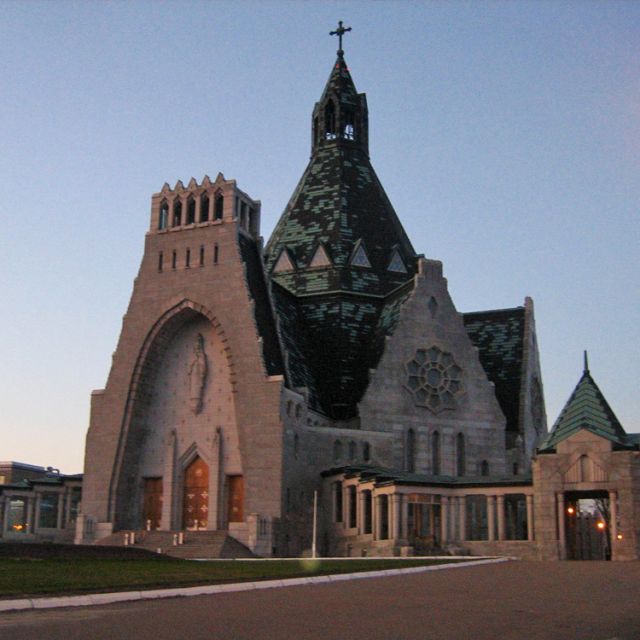Lepage, realizing the thundering power of the river here, built a dam, established a mill and created an industry for locals in harvesting the area’s mighty oaks. Colonies were forbidden from manufacturing finished products, so the lumber was shipped to the navy yards of France for shipbuilding.
About then, iron was discovered and Lepage added a forge. Successive seigniors added a bakery, fabric factory, nail production, kiln for drying grain and couperage. Genevieve, widow of seignior Joseph Masson, built a huge manor house, now an elite private girls school, College Blessed Sacrament. Terrebonne now has a population of 100,000, a tribute to the vision of Fr. Lepage, and draws thousands to its all-season festivals.
Further north stands Abbaye Val Notre-Dame, described as “nature holding its breath.” This is home for 20 Trappist monks who, until 2009, were located in Oka, famous for its cheese.
They relocated in the shadow of the Montagne Coupee at St. Jean-de- Matha to regain an environment of tranquility and closeness to nature.
Instead of a traditional monastery, they’ve built a glass and wood contemporary abbey, harmonizing with the area’s natural beauty. Light pours in from all four sides. Retreatants and visitors are welcomed, inspired by the glories of God’s creation. A large gift shop offers a unique variety of religious and food selections.
Visitors to Lavaltrie can tour the birthplace of Rosalie Cadron-Jette, founder of the Sisters of Mercy. Cadron, born in 1794, was mother to 11 children, six of whom survived. After marrying Jean Jette in 1811, the family experienced terrible hardship. In 1832, Jette died and Cadron continued helping the poor, particularly unmarried women who were pregnant and rejected by society. She would house them in her small home and in the homes of her children.
Eventually, several other women joined her to assist.
In 1848 Bishop Bourget requested that Cadron establish a religious community devoted to helping unmarried pregnant women, both before and after the births of their babies. She and her community became professional midwives. Today, in this modest home, visitors can learn her story. Her Sisters serve worldwide in hospitals and institutions and there is a strong movement for her beatification.
The second “authentic Quebec” region, Mauricie, adjoins Lanaudiere. Its most famous Catholic heritage site is Our Lady of the Cape Shrine in Trois Rivières. Its magnificent basilica seats 2,000 and its Casavant organ has 5,549 pipes and 75 organ stops. Equally breathtaking are its stained glass windows by Fr. Jan Tillemans, OMI, featuring Chartres Cathedral-type stained glass, each piece hand-cut.
When Pope John Paul II visited here in 1984 he prayed in the small chapel off to the side of the basilica, where the last of the three miracles leading to the building of the shrine took place. It was there that Fr. Desilets (who was fervently devoted to the rosary and who was beatified in 1988) and two friends witnessed the eyes on the statue of the Blessed Virgin move from a lowered position to gazing at them intently for five to 10 minutes. Today over 300,000 pilgrims a year visit, many to celebrate the feast of the Assumption on Aug. 15 and to enjoy the shrine’s beautiful gardens.
Other inspirational religious sites in Mauricie include the historic Museum of the Ursulines (Trois Rivieres); the art work in Our Lady of the Visitation Church (Champlain); the works of famed artist Ozias Leduc in Our Lady of the Presentation Church; and the exceptional 10 stained glass depictions of the life of St. Peter in St. Peter’s Church (Shawinigan). All this — and more — amid the unspoiled nature and classic cuisine of an “authentic” Quebec.
For information: www.bonjourquebec.com or 1-877-266-5687.
(O’Donnell Williams is author of Memories of the Beach: Reflections on a Toronto Childhood.)
Catholic heritage stays strong in ‘Authentic Quebec’
By Lorraine O’Donnell Williams, Catholic Register SpecialThe regions of Lanaudiere and Mauricie, known together as “Authentic Quebec,” offer a contrast to the sophisticated metropolis of Montreal. Both regions are rich in Catholic heritage.
Beginning a half hour east of Montreal, they are bordered in the south by Le Chemin Du Roy (the King’s Highway), which connects Quebec City to Montreal along the St. Lawrence River, and in the north by lakes and dense forests.
In Lanaudiere, visiting the town of Terrebonne I learned of the work of Fr. Louis Lepage, the “seignior” of this land in 1720 who built the first church. Today the site, Ile des Moulins, is one of only two important reconstructed Quebec heritage sites.
Please support The Catholic Register
Unlike many media companies, The Catholic Register has never charged readers for access to the news and information on our website. We want to keep our award-winning journalism as widely available as possible. But we need your help.
For more than 125 years, The Register has been a trusted source of faith-based journalism. By making even a small donation you help ensure our future as an important voice in the Catholic Church. If you support the mission of Catholic journalism, please donate today. Thank you.
DONATE

